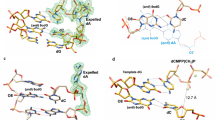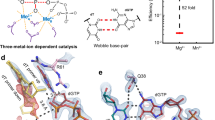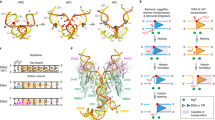Abstract
Certain dyes1,2 and drugs3,4 with planar aromatic components can intercalate these into stacks of base pairs and thereby bind tightly to DNA duplexes. Intercalation at one site usually precludes intercalation between the base pairs immediately adjacent5. This exclusion implies that two distinct nucleoside conformations are needed in the dinucleoside phosphates which include the intercalation site. The simplest distinction would involve no more than quantitative differences in the (usually anti) conformations at the glycosidic bonds6. This could be reinforced by additional, qualitative differences in the furanose ring puckerings (C-2′-endo and C-3′-endo)7. For the most pronounced difference there could be qualitative differences (syn and anti) in the conformations of the glycosidic bonds as well as in the conformations of the sugar rings. The model discussed here is an example of this most emphatic distinctiveness, as the nucleosides at the 5′ ends of the intercalation sites are C-3′-endo and syn and at the 3′ ends are C-2′-endo and anti. X-ray diffraction analysis suggests that a completely unwound allomorph of the DNA duplex can persist in oriented fibres when stabilized by certain platinum-containing intercalators. In the untwisting of (usually) right-handed DNA double helices, unwound duplexes are presumably fleeting intermediates.
This is a preview of subscription content, access via your institution
Access options
Subscribe to this journal
Receive 51 print issues and online access
$199.00 per year
only $3.90 per issue
Buy this article
- Purchase on Springer Link
- Instant access to full article PDF
Prices may be subject to local taxes which are calculated during checkout
Similar content being viewed by others
References
Lerman, L. S. J. molec. Biol. 3, 18–30 (1961).
Lerman, L. S. Proc. natn. Acad. Sci. U.S.A. 49, 94–102 (1963).
Waring, M. J. Biochim. biophys. Acta 87, 358–361 (1964).
Bauer, W. & Vinograd, J. J. molec. Biol. 47, 419–435 (1970).
Crothers, D. M. Biopolymers 6, 575–584 (1968).
Shieh, H.-S., Herman, H. M., Dabrow, M. & Neidle, S. Nucleic Acids Res. 8, 85–97 (1980).
Sobell, H. M., Tsai, C.-C., Jain, S. C. & Gilbert, S. G. J. molec. Biol. 114, 333–365 (1977).
Alden, C. J. & Arnott, S. Nucleic Acids Res. 2, 1701–1717 (1975).
Alden, C. J. & Arnott, S. Nucleic Acids Res. 4, 3855–3861 (1977).
Bond, P. J., Langridge, R., Jennette, K. W. & Lippard, S. J. Proc. natn. Acad. Sci. U.S.A. 72, 4825–4829 (1975).
Lippard, S. J., Bond, P. J., Wu, K. C. & Bauer, W. R. Science 194, 726–728 (1976).
Drew, H. R., Dickerson, R. E. & Itakura, K. J. molec. Biol. 125, 535–543 (1978).
Wang, A. H.-J. et al. Nature 282, 680–686 (1979).
Arnott, S., Chandrasekaran, R., Birdsall, D. L., Leslie, A. G. W. & Ratliff, R. L. Nature 283, 743–745 (1980).
Arnott, S. Trans. Am. Crystallogr. 9, 31–56 (1973).
Smith, P. J. C. & Arnott, S. Acta crystallogr. A34, 3–11 (1978).
Franklin, R. E. & Gosling, R. G. Acta crystallogr. 6, 673–677 (1953).
Arnott, S. 1st Cleveland Symp. Macromolecules, 87–104 (Elsevier, Amsterdam, 1977).
Leslie, A. G. W., Arnott, S., Chandrasekaran, R. & Ratliff, R. L. J. molec. Biol. (in the press).
Patel, D. J., Canuel, L. L. & Pohl, F. M. Proc. natn. Acad. Sci. U.S.A. 76, 2508–2511 (1979).
Author information
Authors and Affiliations
Rights and permissions
About this article
Cite this article
Arnott, S., Bond, P. & Chandrasekaran, R. Visualization of an unwound DNA duplex. Nature 287, 561–563 (1980). https://doi.org/10.1038/287561a0
Received:
Accepted:
Issue Date:
DOI: https://doi.org/10.1038/287561a0
This article is cited by
-
Pairing of unwound DNA duplexes as hypothetical intermediates in genetic recombination
Naturwissenschaften (1986)
Comments
By submitting a comment you agree to abide by our Terms and Community Guidelines. If you find something abusive or that does not comply with our terms or guidelines please flag it as inappropriate.



